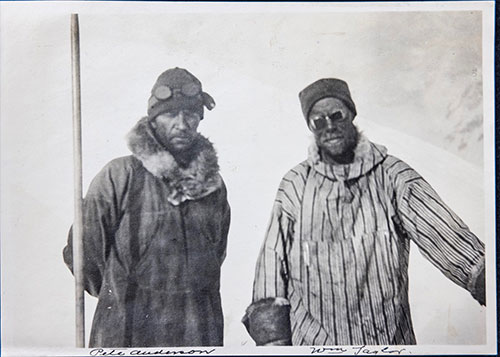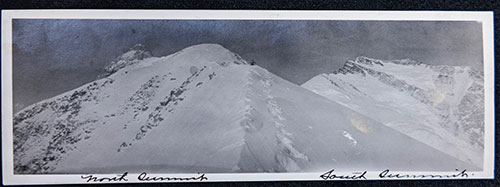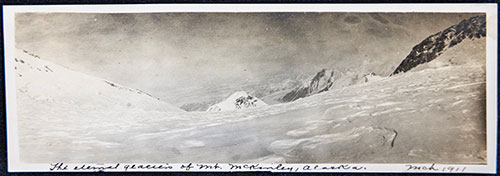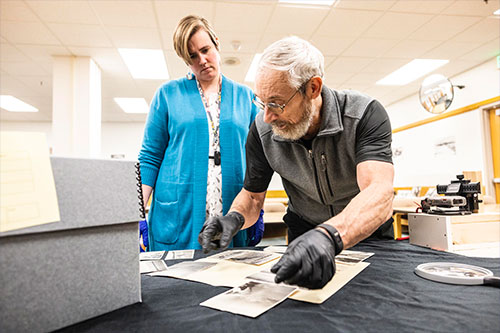Sourdough4 - In this photo, previously unpublished until now as far as is known, Charlie McGonagal, left, and Pete Anderson, two of the four-man Sourdough Expedition that ascent of Denali’s North Peak, are shown. |
“The photographs took my breath away. We have never seen pictures of these men climbing,” Sturm said. “This is photographic evidence that we've never had before.”
The New York Times on June 5, 1910, carried three full pages about the climb under the headline “First account of conquering Mount McKinley” and included a photograph made at about 11,000 feet. Other photographs were from lower elevations and included a fake photo created to illustrate the summit.
The Times coverage included a lengthy overview story by Fairbanks Daily News-Miner Editor W.F. Thompson and a separate detailed account of the ascent told by climb organizer Tom Lloyd. The News-Miner had been a big booster of the summit claims.
Within weeks of the Times story, however, the climb was largely discredited as hoax and remained so until 1918 when Hudson Stuck published his book on his successful 1913 ascent of the south — and higher — summit.
The sourdoughs — Lloyd, Pete Anderson, Charlie McGonagal and Billy Taylor — didn’t know at the time that the North Peak is about 850 feet lower than the South Peak. The 1910 Sourdough Expedition climb is believed to be the first to summit either peak.
The archive photographs and Sturm’s additional research in the diaries of the Stuck party support the claim by Sourdough Expedition members that they indeed planted a flag on the North Peak in 1910. All of Stuck’s team saw the 14-foot spruce flagpole three years after it was erected.
Sturm and climbing partner Philip Marshall used maps and digital software to locate where each of the photographs in the Times story and the newly discovered photographs were taken.
This photograph shows a climber in the distance at about 13,000 feet on what today is known as Karstens Ridge on Denali. Indentations to the left of the footprints are believed to be from a 14-foot spruce flagpole strapped across a climber’s back. The pole was to be planted on the summit.
This photograph was made at about 16,500 feet and looks down the 20,310-foot mountain. Matthew Sturm and colleague Philip Marshall used maps and digital software to pinpoint the locations where the photographs were made. This photo is mislabeled as March 1911. |
Sturm, a climber himself with some experience on Denali and extensive knowledge about the mountain’s climbing history, found the photographs while conducting unrelated research in the donated family collection of Doris Day, daughter of a woman who came to Alaska in the gold rushes of 1897 through 1903. Day acquired the photographs upon the death of her mother, who was editor of another Fairbanks newspaper and a friend of Taylor’s.
Sturm noticed a reference to a climb on the collection contents list. A folder inside the file box read, “Taylor-Peterson McKinley Climb, March 1911.”
There was no 1911 climb, so Sturm knew the folder could only be a trove of mislabeled photographs of the 1910 Sourdough Expedition, which occurred in the first week of April that year.
The folder contains pictures of the climbers en route, a unique alpenstock climbing staff carried by Anderson and the flagpole. The folder also holds several scenic photos.
One photo looks back down the mountain from about 14,500 feet. Sturm determined from shadows in this photo that the time was about 4 p.m., too late in the day for the men to reach the summit but light enough for them to climb a little higher and make another photograph.
That higher photograph, also in the folder, is a panorama looking down from the surface of Harper Glacier at about 16,500 feet elevation. No known photograph shows them any higher.
Rasmuson Library archivist Rachel Cohen and professor Matthew Sturm look at Sourdough Expedition photographs that Sturm unexpectedly found during unrelated research. |
From the photographs and other research, Sturm theorizes the men tried for the summit two days later.
By relating the Times photos and the newly found photos to the correct locations on a map, and using information from a 1939 Taylor interview, Sturm and Marshall reasoned that Taylor, Peterson and McGonagal left camp in the predawn hours from 11,000 feet. McGonagal faltered at some point and was left to wait. Taylor and Peterson continued and planted the 14-foot pole and flag in a rocky area a few hundred feet shy of the frozen and rockless North Peak.
Lloyd returned to Fairbanks later in April, about two months before the other three men, and announced all four climbers had reached the mountain’s “two summits.” He was met with local skepticism, however, because he had no summit photographs and was not physically fit for climbing.
The other climbers remained at Kantishna, working their mining claims, and didn’t return to Fairbanks until June — after the exaggerated claims of the New York Times story had been published.
Questions about the Sourdough Expedition have persisted for more than a century. Photos and research by Sturm add to the story.
“What has emerged is a better, richer, more human story about these men and their climb,” Sturm said.
This article is provided as a public service by the University of Alaska Fairbanks' Geophysical Institute. ROD BOYCE [rcboyce@alaska.edu] is a science writer with the Geophysical Institute. |
Representations of fact and opinions in comments posted are solely those of the individual posters and do not represent the opinions of Sitnews.
Send a letter to the editor@sitnews.us
SitNews ©2022
Stories In The News
Ketchikan, Alaska
Articles & photographs that appear in SitNews are considered protected by copyright and may not be reprinted without written permission from and payment of any required fees to the proper freelance writers and subscription services.
E-mail your news & photos to editor@sitnews.us
Photographers choosing to submit photographs for publication to SitNews are in doing so granting their permission for publication and for archiving. SitNews does not sell photographs. All requests for purchasing a photograph will be emailed to the photographer.




